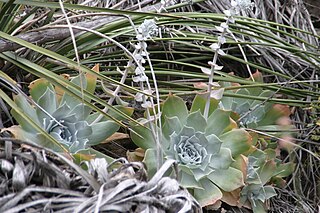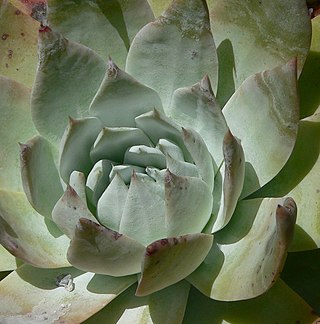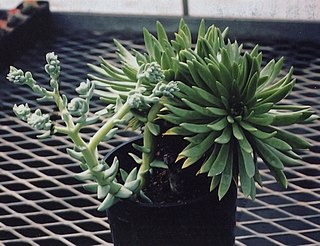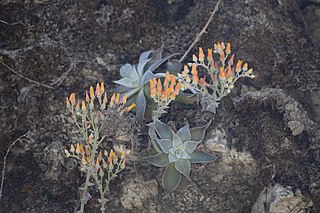
Dudleya, commonly known as liveforevers, is a genus of rosette-forming succulent plants in the stonecrop family, Crassulaceae, consisting of about 68 taxa in southwestern North America and Guadalupe Island. The species come in many forms, some large and evergreen, others geophytic and deciduous. Yet, despite their dramatic variations in appearance, most species readily hybridize. The flowers of Dudleya have parts numbered in fives, with the petals arranged in tubular, star-shaped, and bell-shaped forms and, when fruiting, are filled with tiny, ovoid-crescent-shaped seeds.

Dudleya candelabrum is a species of succulent plant known by the common names candleholder liveforever or candleholder dudleya. Endemic to California, this species grows wild only on the northern Channel Islands, where it is found in open rocky places and north-facing slopes. It is characterized by thin, spade-shaped green leaves and an inflorescence covered in long, reflexed bracts, with pale yellow flowers. It has been threatened by poachers shipping plants to South Korea.

Dudleya farinosa is a species of succulent plant in the family Crassulaceae known by several common names, including bluff lettuce, powdery liveforever, and powdery dudleya. A coastal plant of northern California and southern Oregon, it is typically found on ocean bluffs just directly above the reach of the waves, and sometimes inland. Its appearance is characterized by lotus-like rosettes of beveled leaves, and in summer the plant erects a tall pink to red peduncle densely covered in bracts, topped with branches of pale yellow flowers. The green or white rosettes of this plant can be seen covering stretches of rocky coast and nearby islets.

Dudleya pulverulenta is a species of perennial succulent plant known by the common names chalk lettuce, chalk dudleya, and chalk liveforever. It is one of the largest Dudleya, with a silvery, waxy rosette that may greatly contrast with its habitat. It is also regarded as one of the most distinctive members of the Dudleya, with one of the most specialized inflorescences in the genus, adapted to hummingbird pollination through its red pendent flowers, the longest corolla, and the highest nectar output. Dudleya pulverulenta has the largest range of all Dudleya, over 1,000 kilometres (620 mi), being found from southern Monterey County in California to the Sierra de San Borja in southern Baja California. It is closely related to Dudleya arizonica, a smaller desert species that tends to lack the specialized floral traits, and Dudleya anthonyi, which differs in a few morphological traits and is restricted to the San Quintín Volcanic Field.

Dudleya attenuata is a species of perennial succulent plant known by the common name taper-tip liveforever, native to Baja California and a small portion of California. It is a rosette-forming leaf succulent which has narrow pencil-shaped leaves that can often be found covered in a white epicuticular wax. The thin, sprawling stems branch to form the clusters of rosettes, with plants creating a "clump" up to 40 cm wide. The small flowers are white or yellow, with 5 spreading petals. It is a diverse, variable species that extends from the southernmost coast of San Diego County to an area slightly north of the Vizcaino Desert, hybridizing with many other species of Dudleya in its range. Some plants with white or pinkish flowers were referred to as Orcutt's liveforever, referring to a former subspecies split on the basis of the flower color.

Dudleya ingens is a species of perennial succulent plant in the family Crassulaceae commonly known as the rock liveforever or Baja liveforever. A relatively large member of the genus Dudleya, this species has long green succulent leaves, and in April to June is characterized by pale yellow to white pink-tinged flowers topping tall, reddish inflorescences. It has a stem clothed densely with old, leathery leaves, and the inflorescence may be nodding, with the floral branches bearing the flowers tending to unfurl like the fronds of a fern. It is similar in appearance to Dudleya brittonii, but differs in range and chromosome number. This species is endemic to the state of Baja California in Mexico, being found from Santo Tomás to the southern coast of the state.

Dudleya anthonyi is a species of perennial succulent plant known commonly as the San Quintín liveforever. It is endemic to the San Quintín volcanic field, which encompasses the Bahia San Quintín and the adjacent Isla San Martín in Baja California. Dudleya anthonyi is a relatively large rosette-forming succulent and is characterized by its leaves and inflorescences that are coated in a white, chalky powder. It is quite similar to its close relative, the widespread Dudleya pulverulenta, but Dudleya anthonyi is distinguished by its narrower and acute basal leaves and bracts, along with narrower and pointed sepals and petals. Like its close relative, Dudleya anthonyi is one of the few members of the genus Dudleya that have a pollination syndrome almost exclusively favoring hummingbird pollinators, adaptations which are reflected by its long, red, and pendent flowers.

Dudleya guadalupensis is a very rare species of succulent perennial plant in the family Crassulaceae commonly known as the Guadalupe liveforever. It is a rosette-forming leaf succulent, with foliage that is variously colored light green, green, and a waxy white. It is characterized by dense leaves that fold over the center in dormancy, a curving, sinuous flower stalk, and white, cup-shaped flowers. It is endemic to the rocks and islets off of Guadalupe Island, an isolated volcanic island in the Pacific Ocean located 241 kilometers off of the coast of Baja California.

Dudleya rigida is a species of succulent perennial plant in the family Crassulaceae known commonly as the La Laguna liveforever. Characterized by a tall inflorescence with pendant yellowish-red flowers, it is a very rare plant whose existence was doubtful until botanist Reid Moran accidentally re-discovered it. It is endemic to the highest peaks of the Sierra de la Laguna in Baja California Sur, Mexico.

Dudleya anomala is a rare species of succulent plant in the family Crassulaceae commonly known as the Todos Santos liveforever. With a dense, cushion-forming habit, this leaf succulent is characterized by elongated stems, slightly sticky leaves, and bell-shaped flowers with white, spreading petals. This species is native to Baja California, Mexico, and is found primarily on islands and one coastal locality.

Dudleya pauciflora is a species of succulent plant in the stonecrop family known by the common name few-flower liveforever. It is characterized by its small crowded rosettes of narrow leaves and its colorful inflorescence with red-yellow flowers. Found growing on rocky outcrops and cliffs in the high elevation mountains of the Sierra de San Pedro Martir and the Sierra de San Borja, it is endemic to the state of Baja California, Mexico.

Dudleya gatesii, known by the common name as Gates'liveforever, is a species of perennial succulent plant in the family Crassulaceae. It is native to the central desert of the Baja California peninsula, found growing along dry and rocky outcroppings. It is characterized by red inflorescences topped with white flowers, bracts that are often reflexed downwards, and a rosette of dark-green leaves turning reddish.

Dudleya pachyphytum is an insular succulent plant known by the common name Cedros Island liveforever. It is a member of the genus Dudleya, in the family Crassulaceae. Characterized by thick, blunt leaves covered in a white, powdery wax and adorned by white flowers in bloom, it is regarded as one of the most attractive and charismatic members of its genus. It is endemic to the foggy northern end of Mexico's Cedros Island, occupying an ecological niche shared with the Cedros Island Pine.

Dudleya linearis is an insular succulent plant known by common name as the San Benitos liveforever. It is a rosette-forming perennial characterized by its long, flat green leaves on clustered heads and its yellow flowers. It is endemic to the western island of the Islas San Benito, a small Mexican archipelago in the Pacific Ocean west of Cedros Island. The limited population of the species is vulnerable, and has twice come close to extinction from introductions of grazing animals.

Dudleya rubens is a species of succulent perennial plant in the family Crassulaceae known by the common name as the San Francisco liveforever, native to the mountains of Baja California Sur. It is a rosette-forming plant with waxy leaves, characterized by branching stems and dull red to apricot flowers. It is only found above 500 metres (1,600 ft) in the Sierra de San Francisco and the Sierra de la Giganta ranges in Baja California Sur, primarily on north-facing volcanic slopes.

Dudleya candida is a species of perennial succulent plant in the family Crassulaceae known by the common names Coronados liveforever or chalk rose. It is a rosette-forming, green to white-colored leaf succulent, and in bloom yellow flowers atop red stalks stand above the foliage. It has some visual similarities to the mainland Dudleya brittonii, and has found uses in horticulture as an ornamental plant. It is restricted to the Coronado Islands, an island group off of the extreme northern Baja California coast, visible from the United States.

Dudleya acuminata is a species of succulent perennial plant in the family Crassulaceae known by common name as the Vizcaino liveforever. A rosette-forming leaf succulent, it has reddish yellow flowers that emerge from April to May. It is native to the Pacific coast of the Vizcaino Desert on the Baja California Peninsula, and on neighboring islands.

Dudleya nubigena is a species of succulent plants in the family Crassulaceae. It is a rosette forming perennial with flattish leaves. Endemic to southern Baja California Sur, the species is found in the Sierra de la Laguna and the surrounding lowlands, a small southern portion of the Sierra de la Giganta, and on Isla Espíritu Santo, with a subspecies endemic to Cerralvo Island.

Dudleya cochimiana, commonly known as the Cochimíliveforever, is a species of succulent plant in the family Crassulaceae endemic to Cedros Island, a large island off of the coast of Baja California, Mexico. It is a rosette-forming leaf succulent characterized by broad, green to white leaves, and flowers with white to pink petals. It can be found on rocky slopes and canyons along the island.

Dudleya cymosasubsp. pumila, most commonly known as the low canyon dudleya, chalky canyon dudleya or California live-forever, is a species of perennial succulent plant. It has diamond to spoon shaped leaves, sometimes coated with a fine white powder, and in May through July, bright red, orange or yellow flowers adorn the short inflorescence. A leaf succulent primarily found growing in rocky cliffs and slopes, it is endemic to California, and grows in the Transverse Ranges and South Coast Ranges, with some outlying populations. A variable plant, in some localities it is difficult to distinguish from other plants in the genus.























